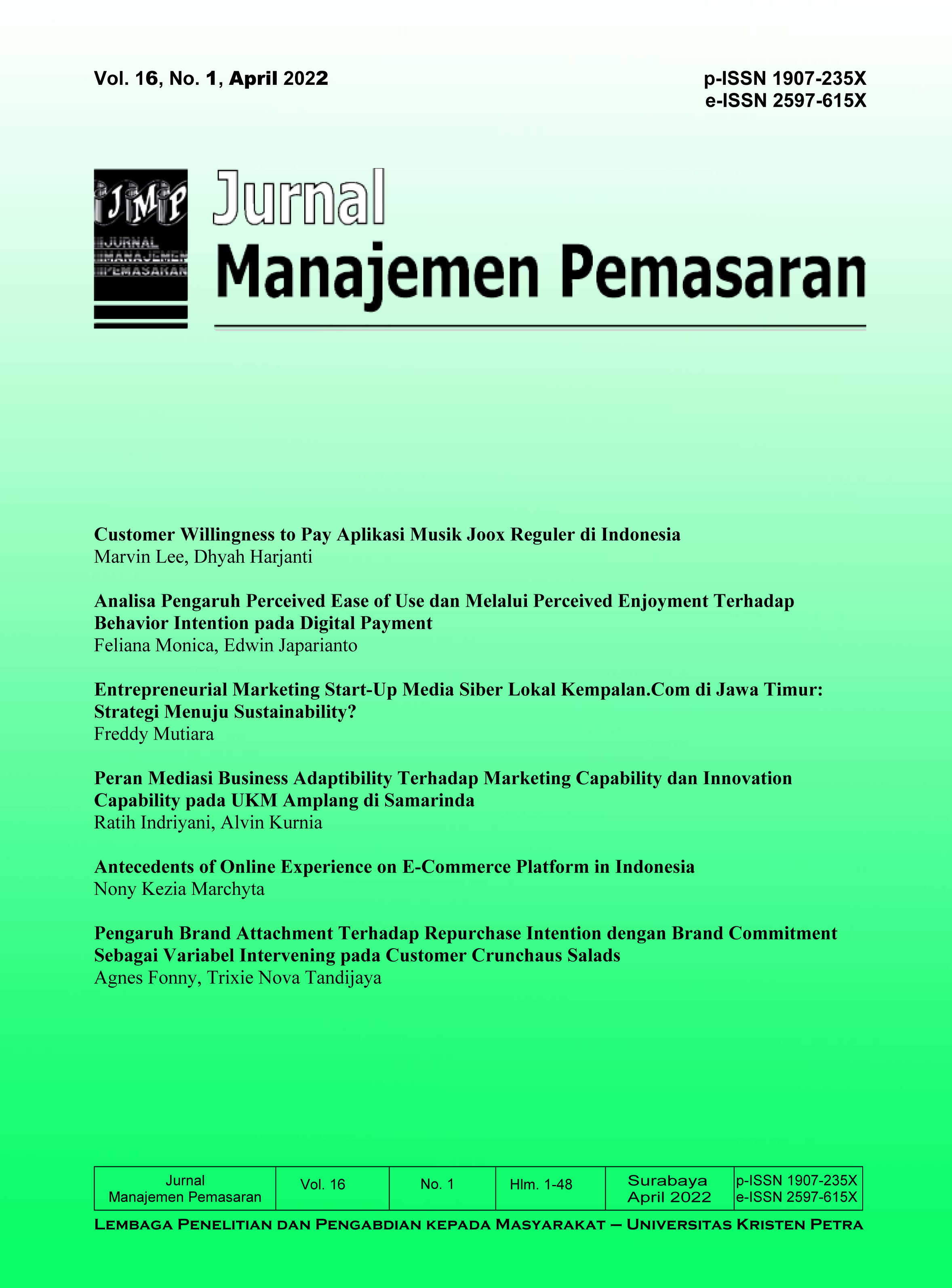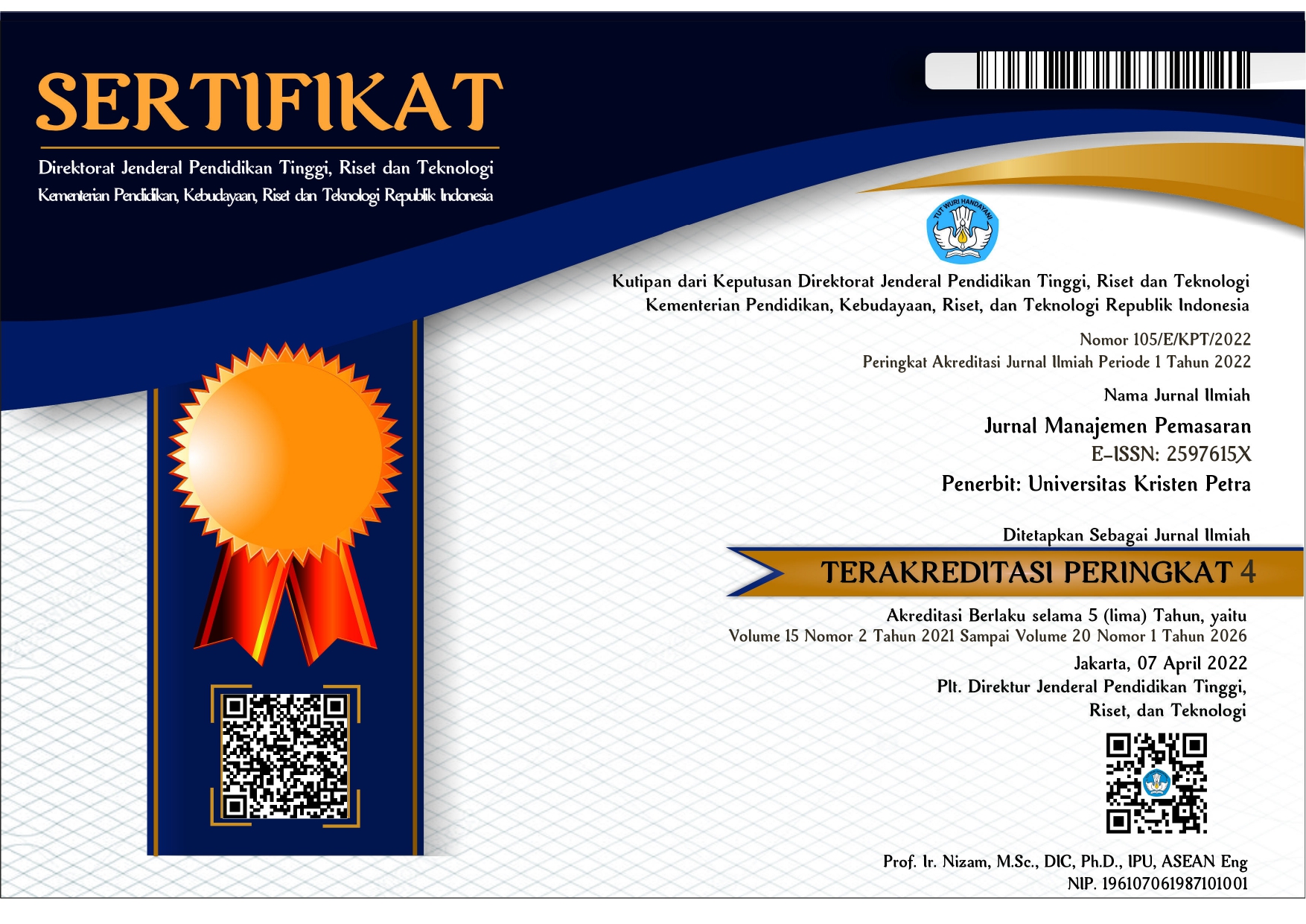CUSTOMER WILLINGNESS TO PAY APLIKASI MUSIK JOOX REGULER DI INDONESIA
DOI:
https://doi.org/10.9744/pemasaran.16.1.1-8Keywords:
Perceived benefit, perceived sacrifice, free mentality, theory of planned behavior, customer willingness to payAbstract
This study examined the role of attitude toward paying, along with subjective norms and perceived behavioral control, to form the willingness of Indonesian consumers to pay Joox music application. Data were gathered by disseminating questionnaires to 394 respondents, then were analysed using Partial Least Square (PLS). The findings confirmed that perceived benefit, perceived sacrifice, and free mentality had a significant influence on attitude toward paying. The results also showed that attitude toward paying, subjective norm, and perceived behavioral control on customer willingness to pay.
Abstrak:
Penelitian ini menguji peran attitude toward paying bersama-sama dengan subjective norm dan perceived behavioral control terhadap customer willingness to pay pengguna aplikasi musik Joox di Indonesia. Data penelitian ini diperoleh dengan mendistribusikan kuesioner pada 394 responden, lalu diolah menggunakan Partial Least Square (PLS). Dari penelitian ini dapat disimpulkan bahwa perceived benefit, perceived sacrifice, dan free mentality berpengaruh terhadap attitude toward paying. Hasil penelitian juga menunjukkan bahwa attitude toward paying, subjective norm, dan perceived behavioral control membentuk kesedian konsumen untuk membayar aplikasi music Joox.
References
Ajzen, I. (1991). The theory of planned behavior. Orga¬nizational Behavior and Human Decision Process 50, 179-211.
Ajzen, I. (2002). Perceived behavioral control, self-efficacy, locus of control, and the theory of planned behavior. Journal of Applied Social Psychology, 32(4), 665-683.
Al-Debei, M. M., Akorush, M. N., & Ashouri, M. I. (2015). Consumer attitudes towards online shopping: The effects of trust, perceived benefits, and perceived web quality. Internet Research, 25(5), 707-733.
APJII. (2018). Penetrasi & profil perilaku pengguna internet Indonesia. Jakarta: Asosiasi Penyeleng-gara Jasa Internet Indonesia. Retrieved September 16, 2019, from https://apjii.or.id/content/ read/39/410/Hasil-Survei-Penetrasi-dan-Perilaku -Pengguna-Internet-Indonesia-2018
Ashton, A. S., Scott, N., Solnet, D., & Breakey, N. (2010). Hotel restaurant dining: The relationship between perceived value and intention to purchase. Tourism and Hospitality Research, 10(3), 206-218.
Bhattacherjee, A. (2000). Acceptance of e-commerce services: The case of electronic brokerages. IEEE Transaction on Systems, Man, and Cybernetics - Part A : Systems and Humans, 30(4), 411-420.
Choi, J., Lee, A., & Ok, C. (2013). The effects of consumers' perceived risk and benefit on attitude and behavioral Intention: a study of street food. Journal of Travel & Tourism Marketing, 30(3), 222-237.
Chyi, H. I. (2005). Willingness to pay for online news: An empirical study on the viability of the sub-scription model. Journal of Media Economics, 18(2), 131-142.
Daily Social. (2018). Online music streaming survey 2018. Jakarta: DailySocial.id.
Kompas.com (2016, March 31). Spotify masuk, total ada 8 layanan "streaming" musik di Indonesia. Retrieved from Kompas: https://tekno.kompas. com/read/2016/03/31/13140017/Spotify.Masuk.Total.Ada.8.Layanan.Streaming.Musik.di.Indonesia?page=all
Digital McKinsey. (2016). The beat of progress : The rise of music streaming in Asia. McKinsey & Company.
Dou, W. (2004). Will internet users pay for online content? Journal of Advertising Research, 349-359.
Fishbein, M., & Ajzen, I. (2010). Predicting and changing behavior: The reasoned action approach. New York: Pyschology Press Taylor & Francis Group.
Ghozali, I., & Latan, H. (2015). Partial least square: konsep, teknik, dan aplikasi menggunakan program SmartPLS 3.0 (2 ed.). Semarang: Badan Penerbit Universitas Diponegoro.
Goyanes, M. (2014). An empirical study of factors that influence the willingness to pay for online news. Journalism Practice, 8(6), 742-757.
Huang, Y.-K. (2010). The effect of arline service quality on passengers' behavioural intentions using servqual scores: A Taiwan case study. Jurnal of the Eastern Asia Society for Transpor-tation Studies, 8, 2330-2343.
Ipsos Connect. (2018). Targeting millenials using mu-sic streaming apps. Hong Kong: Ipsos Connect.
Javadi, M. H., Dolatabadi, H. R., Nourbakhsh, M., Poursaeedi, A., & Asadollahi, A. R. (2012). An analysis of factors affecting on online shopping behavior of consumers. International Journal of Marketing Studies, 4(5), 81-98.
Kim, H.-W., Chan, H. C., & Gupta, S. (2007). Value-based adoption of mobile internet: an empirical investigation. Decision Support System, 43, 111-126.
Lee, D., Park, J. Y., Kim, J., Kim, J., & Moon, J. (2011). Understanding music sharing behaviour on social network services. Online Information Review, 35(5), 716-733.
Lemeshow, S., Hosmer, D. W., Klar, J., & Lwanga, S. K. (1990). Adequacy of sample size in health studies. Chichester: John Wiley & Sons.
Liebe, U., Preisendörfer, P., & Meyerhoff, J. (2011). To pay or not to pay: Competing theories to explain individuals’ willingness to pay for public environmental goods. Environment and Beha-vior, 43(1), 106-130.
Lin, T.-C., Hsu, J. S.-C., & Chen, H.-C. (2013). Customer willingness to pay for online music : The role of free mentality. Journal of Electronic Commerce Research, 14(4), 315-333.
Liu, T. M., Brock, J. L., Shi, G. C., Chu, R., & Tseng, T.-H. (2013). Perceived benefits, perceived risk, and trust: Influences on consumers’ group buying behaviour. Asia Pacific Journal of Marketing and Logistics, 25(2), 225-248.
Maasø, A. (2016). Music streaming, festivals, and the eventization of music. Popular Music and Society, 41(2), 154-175.
Sarstedt, M., Ringle, C. M., & Hair, J. F. (2017). Partial least square: Structural equation modeling. In C. Homburg, M. Klarmann, & A. Vomberg, Hand-book of Marketing Research. Springer, Cham.
Shin, Y. H., & Hancer, M. (2016). The role of attitude, subjective norm, perceived behavioral control, and moral norm in the intention to purchase local food products. Journal of Foodservice Business Research, 1-14.
Suki, N. M. (2011). Modelling early adopters' purchase intention towards online music. Middle-East Journal of Scientific Research, 7(6), 827-836.
Vlachos, P., Vrechopoulos, A. P., & Doukidis, G. (2003). Exploring consumer attitudes towards mobile music services. International Journal on Media Management, 5(2), 138-148.
Wang, C.-Y., Chang, H.-C., Chou, S.-C. T., & Chen, F.-F. (2013). Acceptance and willingness to pay for mobile TV apps. PACIS 2013 Proccedings, 260, 1-15.
Wlömert, N., & Papies, D. (2016). On-demand streaming services and music industry revenues - Insight from Spotify's market entry. Internation Journal of Research in Marketing, 314-327.
Yan, J., & Wakefield, R. (2018). The freemium (two-taired) model for individual cloud services: Factors bridging the free tier and the paying tier. Journal of Information Technology Manage-ment, 29(1), 47-61.

















